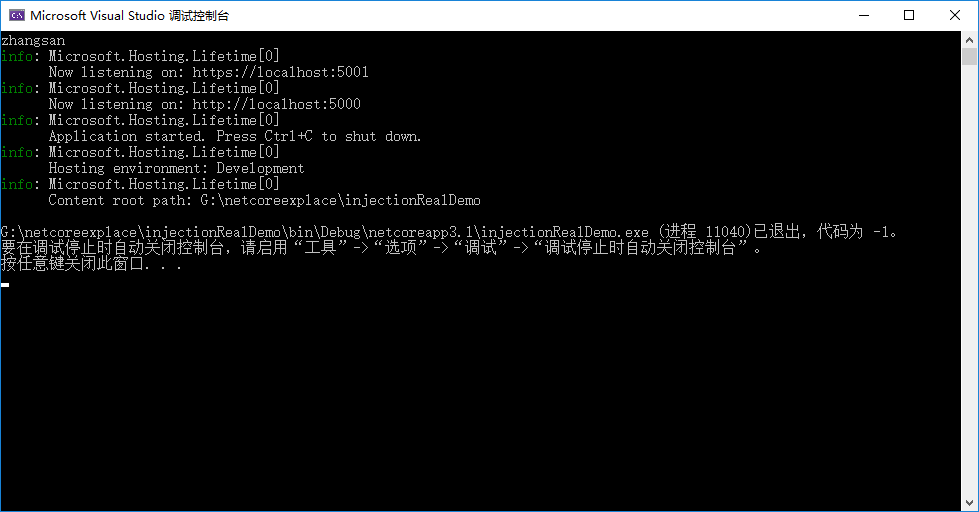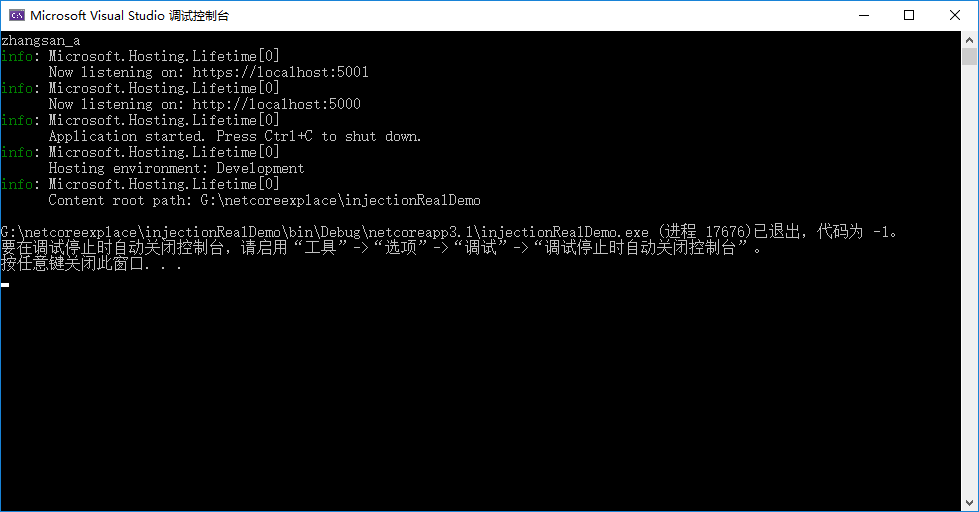重新整理 .net core 实践篇—————服务与配置之间[十一二]
前言
前面基本介绍了,官方对于asp .net core 设计配置和设计服务的框架的一些思路。看下服务和配置之间是如何联系的吧。
正文
服务:
public interface ISelfService
{
string ShowOptionName();
}
public class SelfService : ISelfService
{
IOptions<SelfServiceOption> _options;
public SelfService(IOptions<SelfServiceOption> options)
{
this._options = options;
}
public string ShowOptionName()
{
return _options.Value.Name;
}
}
实体配置类:
public class SelfServiceOption
{
public string Name { get; set; }
}
配置:
"SelfService": {
"name" : "zhangsan"
}
注册:
services.AddSingleton<ISelfService, SelfService>();
services.Configure<SelfServiceOption>(Configuration.GetSection("SelfService"));
获取调用在startup.Configure中:
var SelfService = app.ApplicationServices.GetService<ISelfService>();
Console.WriteLine(SelfService.ShowOptionName());
结果:

经过前面系列中,我们非常好的能够理解:services.Configure
在反射通过属性获取值过程中就是SelfService+":"+属性名,对字典进行获取对应的值。
那么看下为什么我们在配置的时候需要IOptions
看下IOptions 的实现类OptionsManager:
public class OptionsManager<TOptions> : IOptions<TOptions>, IOptionsSnapshot<TOptions> where TOptions : class, new()
{
private readonly IOptionsFactory<TOptions> _factory;
private readonly OptionsCache<TOptions> _cache = new OptionsCache<TOptions>(); // Note: this is a private cache
/// <summary>
/// Initializes a new instance with the specified options configurations.
/// </summary>
/// <param name="factory">The factory to use to create options.</param>
public OptionsManager(IOptionsFactory<TOptions> factory)
{
_factory = factory;
}
/// <summary>
/// The default configured <typeparamref name="TOptions"/> instance, equivalent to Get(Options.DefaultName).
/// </summary>
public TOptions Value
{
get
{
return Get(Options.DefaultName);
}
}
/// <summary>
/// Returns a configured <typeparamref name="TOptions"/> instance with the given <paramref name="name"/>.
/// </summary>
public virtual TOptions Get(string name)
{
name = name ?? Options.DefaultName;
// Store the options in our instance cache
return _cache.GetOrAdd(name, () => _factory.Create(name));
}
}
那么我们调用Value 其实是调用IOptionsFactory的_factory.Create(name)。
查看一下,IOptionsFactory的实现类OptionsFactory,看里面的create方法。:
public class OptionsFactory<TOptions> : IOptionsFactory<TOptions> where TOptions : class, new()
{
private readonly IEnumerable<IConfigureOptions<TOptions>> _setups;
private readonly IEnumerable<IPostConfigureOptions<TOptions>> _postConfigures;
private readonly IEnumerable<IValidateOptions<TOptions>> _validations;
/// <summary>
/// Initializes a new instance with the specified options configurations.
/// </summary>
/// <param name="setups">The configuration actions to run.</param>
/// <param name="postConfigures">The initialization actions to run.</param>
public OptionsFactory(IEnumerable<IConfigureOptions<TOptions>> setups, IEnumerable<IPostConfigureOptions<TOptions>> postConfigures) : this(setups, postConfigures, validations: null)
{ }
/// <summary>
/// Initializes a new instance with the specified options configurations.
/// </summary>
/// <param name="setups">The configuration actions to run.</param>
/// <param name="postConfigures">The initialization actions to run.</param>
/// <param name="validations">The validations to run.</param>
public OptionsFactory(IEnumerable<IConfigureOptions<TOptions>> setups, IEnumerable<IPostConfigureOptions<TOptions>> postConfigures, IEnumerable<IValidateOptions<TOptions>> validations)
{
_setups = setups;
_postConfigures = postConfigures;
_validations = validations;
}
/// <summary>
/// Returns a configured <typeparamref name="TOptions"/> instance with the given <paramref name="name"/>.
/// </summary>
public TOptions Create(string name)
{
var options = new TOptions();
foreach (var setup in _setups)
{
if (setup is IConfigureNamedOptions<TOptions> namedSetup)
{
namedSetup.Configure(name, options);
}
else if (name == Options.DefaultName)
{
setup.Configure(options);
}
}
foreach (var post in _postConfigures)
{
post.PostConfigure(name, options);
}
if (_validations != null)
{
var failures = new List<string>();
foreach (var validate in _validations)
{
var result = validate.Validate(name, options);
if (result.Failed)
{
failures.AddRange(result.Failures);
}
}
if (failures.Count > 0)
{
throw new OptionsValidationException(name, typeof(TOptions), failures);
}
}
return options;
}
}
切开三段看:
第一段
var options = new TOptions();
foreach (var setup in _setups)
{
if (setup is IConfigureNamedOptions<TOptions> namedSetup)
{
namedSetup.Configure(name, options);
}
else if (name == Options.DefaultName)
{
setup.Configure(options);
}
}
上面是实例化我们的配置类。
namedSetup.Configure(name, options); 就是给我们selfServiceOption具体绑定。
这就要回到我们注入的地方了。
services.Configure<SelfServiceOption>(Configuration.GetSection("SelfService"));
来看下Configure 写的是什么,自己看具体的实现哈:
public static IServiceCollection Configure<TOptions>(this IServiceCollection services, string name, IConfiguration config, Action<BinderOptions> configureBinder)
where TOptions : class
{
if (services == null)
{
throw new ArgumentNullException(nameof(services));
}
if (config == null)
{
throw new ArgumentNullException(nameof(config));
}
services.AddOptions();
services.AddSingleton<IOptionsChangeTokenSource<TOptions>>(new ConfigurationChangeTokenSource<TOptions>(name, config));
return services.AddSingleton<IConfigureOptions<TOptions>>(new NamedConfigureFromConfigurationOptions<TOptions>(name, config, configureBinder));
}
AddOptions方法 就是注册具体实现的。
public static IServiceCollection AddOptions(this IServiceCollection services)
{
if (services == null)
{
throw new ArgumentNullException(nameof(services));
}
services.TryAdd(ServiceDescriptor.Singleton(typeof(IOptions<>), typeof(OptionsManager<>)));
services.TryAdd(ServiceDescriptor.Scoped(typeof(IOptionsSnapshot<>), typeof(OptionsManager<>)));
services.TryAdd(ServiceDescriptor.Singleton(typeof(IOptionsMonitor<>), typeof(OptionsMonitor<>)));
services.TryAdd(ServiceDescriptor.Transient(typeof(IOptionsFactory<>), typeof(OptionsFactory<>)));
services.TryAdd(ServiceDescriptor.Singleton(typeof(IOptionsMonitorCache<>), typeof(OptionsCache<>)));
return services;
}
重点来看下NamedConfigureFromConfigurationOptions 这个东西:
public class NamedConfigureFromConfigurationOptions<TOptions> : ConfigureNamedOptions<TOptions>
where TOptions : class
{
/// <summary>
/// Constructor that takes the <see cref="IConfiguration"/> instance to bind against.
/// </summary>
/// <param name="name">The name of the options instance.</param>
/// <param name="config">The <see cref="IConfiguration"/> instance.</param>
public NamedConfigureFromConfigurationOptions(string name, IConfiguration config)
: this(name, config, _ => { })
{ }
/// <summary>
/// Constructor that takes the <see cref="IConfiguration"/> instance to bind against.
/// </summary>
/// <param name="name">The name of the options instance.</param>
/// <param name="config">The <see cref="IConfiguration"/> instance.</param>
/// <param name="configureBinder">Used to configure the <see cref="BinderOptions"/>.</param>
public NamedConfigureFromConfigurationOptions(string name, IConfiguration config, Action<BinderOptions> configureBinder)
: base(name, options => config.Bind(options, configureBinder))
{
if (config == null)
{
throw new ArgumentNullException(nameof(config));
}
}
}
NamedConfigureFromConfigurationOptions 继承ConfigureNamedOptions是不是很眼熟了。
看下我们第一段调用部分:
if (setup is IConfigureNamedOptions<TOptions> namedSetup)
{
namedSetup.Configure(name, options);
}
后面就会调用NamedConfigureFromConfigurationOptions的Configure。
看下NamedConfigureFromConfigurationOptions的实例化方法,传递方法的第二个参数,options => config.Bind(options, configureBinder);
这个bind 是不是特别的眼熟,就是用来实体类绑定配置的,如有疑问可以看下前面几篇,讲述了绑定过程。
那么看下ConfigureNamedOptions的Configure(NamedConfigureFromConfigurationOptions继承ConfigureNamedOptions) 做了什么吧,我们来到ConfigureNamedOptions:
public Action<TOptions> Action { get; }
public ConfigureNamedOptions(string name, Action<TOptions> action)
{
Name = name;
Action = action;
}
public virtual void Configure(string name, TOptions options)
{
if (options == null)
{
throw new ArgumentNullException(nameof(options));
}
// Null name is used to configure all named options.
if (Name == null || name == Name)
{
Action?.Invoke(options, Dependency);
}
}
这时候就会调用传递进来的Action:options => config.Bind(options, configureBinder),传递的这个options就是我们实例化的SelfServiceOption。
configureBinder 是一个配置哈,这是个配置的,下面第二个参数,如果没穿默认是一个()=>{};
如果需要传递可以这么写:
services.Configure<SelfServiceOption>(Configuration.GetSection("SelfService"), BinderOptions =>
{
BinderOptions.BindNonPublicProperties = true;
});
是不是很眼熟,就是设置可以绑定私有属性的选项。
这就把我们的SelfServiceOption 和 Configuration.GetSection("SelfService") 已经绑定了。
那么来看第二段:
foreach (var post in _postConfigures)
{
post.PostConfigure(name, options);
}
这个是什么呢? 这个是这样的,比如说我们的现在获取到了配置,得到了实体类SelfServiceOption,里面的name 是zhangsan。
这个PostConfigure 可以帮我们做后续修改,比如说我获取到了是zhangsan,但是呢,我想做一个判断,如果name 是zhangsan,就加一个后缀,name= name+"_a";
大概就是一些后续操作。
services.AddOptions<SelfServiceOption>().Configure((options) =>
{
if (options.Name == "zhangsan")
{
options.Name = "zhangsan_a";
}
});
效果如下:

第三段
if (_validations != null)
{
var failures = new List<string>();
foreach (var validate in _validations)
{
var result = validate.Validate(name, options);
if (result.Failed)
{
failures.AddRange(result.Failures);
}
}
if (failures.Count > 0)
{
throw new OptionsValidationException(name, typeof(TOptions), failures);
}
}
这一段很显然就是来验证我们的配置是否符合规格。源码就不解释了,实践篇注重实践。
看下怎么用的吧。
services.AddOptions<SelfServiceOption>().Configure((options) =>
{
if (options.Name == "zhangsan")
{
options.Name = "zhangsan_a";
}
}).Validate(options =>
{
return options.Name != "zhangsan_a";
});
然后就会报错。因为上面的逻辑是如果zhangsan,那么我把名字改成zhangsan_a,然后验证里面写名字不能等于zhangsan_a。

结
以上只是个人整理,如有错误,望请指点。
下一节,服务中的配置热更新。


 浙公网安备 33010602011771号
浙公网安备 33010602011771号